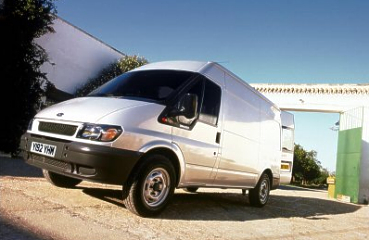
This Week:
-
Chrysler Group Sets Starting Price for All-New 2002 Jeep(R) Liberty At Well Under $20,000
. -
BMW Group Continues to Invest in Product Offensive: Increase in Sales in the First Quarter
. -
First independent automotive logistics group in Europe to acquire Renaults logistics subsidiary CAT
. -
Honda
Motor Announces Development Of Breakthrough Emission Control System
. -
OnStar's Newest Batman Commercial To Debut On Academy Awards Show
. Dana Corporation Reorganizes Commercial Vehicle Systems Unit
© 1998
- 2001 Copyright &
Disclaimer
Automotive Intelligence,
www.autointell.com
All Rights Reserved .
For questions please contact
editor@autointell.com

News of March 28, 2001
All-New Ford Transit Wins Arctic Test

Ford Transit
Photo: Ford
COLOGNE, Germany - The all-new Ford Transit has secured another success, winning the prestigious Artic Van Test of 2001, held in Lapland. The award-winning Transit beat seven vehicles from the fiercely competitive one-tonne sector of the commercial vehicle market.
"I am particluarly delighted that the new Transit has scored so well in this test. It confirms the vehicle's outstanding commercial vehicle attributes in the most arduous conditions," said Martin Leach, Vice President Product Development, Ford of Europe.
This was the eighth Artic Van Test run by the leading Finnish commercial vehicle publication Auto Tekniikka ja Kuljetus. Journalists from Finland, Norway, Sweden and the Baltic countries were involved in the testing.
The competition is open to all medium commercial vans with at least six cubic metres load capacity and a GVM (Gross Vehicle Mass) of up to 3.2 tonnes. The front-wheel-drive Ford Transit 280S was competing against rivals from VW, Hyundai, Toyota, Mazda, Citroen, Fiat and Peugeot.
The Artic Van Test is a rigorous examination in extreme weather conditions. It involves a series of tests over five days that evaluate the vehicles' suitability for artic conditions, including cold weather starting as well as drivability and braking in slippery conditions. Private circuit driving is combined with 1,700 km on Lapland's icy public roads.
After this exhaustive programme of testing the Ford Transit emerged as a clear winner and gained particular praise for its ABS braking system, driver comfort and fuel economy that provides an outstanding driving range.
Background information on the all-new Ford Transit
The all-new Ford Transit represents a significant milestone in the 35 years since the vehicle was introduced in 1965, redefining the European medium van market. The new Transit has been conceived and evolved by a global team from an all-new commercial vehicle platform. It has been designed to deliver significant advances for the customer in load box functionality; low cost of ownership; durability; strength and quality; and security.
The biggest challenge has been the creation of a common platform for both rear and - for the first time in Transit's 35-year history - front-wheel drive vehicles. Recognizing that the one-tonne segment has been moving towards front-wheel drive low-floor configuration, and that the two-tonne segment favours a rear-wheel drive solution, the Transit team set out to deliver an all-new platform for both configurations, with an engine bay that would accept east/west as well as north/south powertrain installations.
Design highlights include:
- Front-wheel or rear-wheel drive with low and high floor.
- North/south and east/west powertrains on the same platform.
- Front- and rear-wheel drive Transits that are identical when viewed from the outside.
- Over 95 percent parts commonality between front-wheel and rear-wheel drive versions.
- The world's biggest one-piece automotive stamping, which is employed for new Transit's steel roof.
- A lower chassis rail height on the chassis cab to benefit aftermarket conversions.
- Three wheelbases including a new medium wheelbase version.
- Four load lengths up to four metres and three roof heights.
- Van, bus and double chassis cab with single and dual rear wheels will be available.
(March 27, 2001)
[Homepage] [
News] [ Companies] [
Management] [ Publications]
[ Events] [ Careers]
[Services] [Discussion] [
Guestbook]
[ Search]